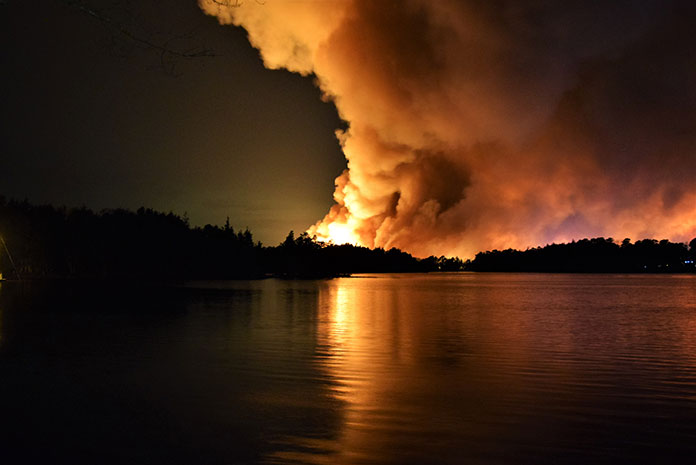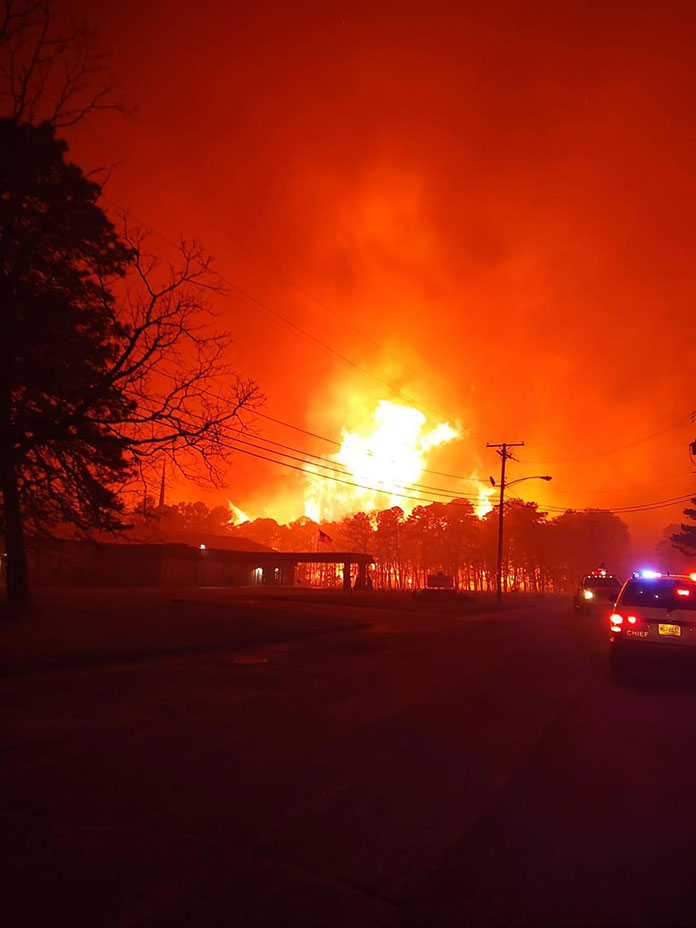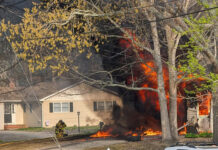
MANCHESTER – It was two years ago this month that area residents watched ash raining down around the Route 70 and Union Avenue traffic circle in Lakehurst Borough amid smoky conditions. From Lake Horicon, you could hear the roar of a powerful wildfire across the water.
This month marks the second anniversary of that devastating wildfire that threatened areas of Manchester Township and Lakehurst. The fire started west of Route 539 on property of Joint Base McGuire-Dix-Lakehurst, but quickly jumped the highway to spread further.
New Jersey Forest Fire Service officials reported at the time that the wildfire had been fueled by winds and dry conditions and headed eastward at about 4.5 miles per hour.
It came to be called “Jimmy’s Waterhole Wildfire” by the Forest Fire Service, for the area where it started. It would go on to burn 4,000 acres of forest as the largest wildfire they had seen in the Manchester area since the 1990s.

On average New Jersey’s forests experience around 1,500 wildfires that damage or destroy 7,000 acres of woodlands each year. Since 1906 the New Jersey Forest Fire Service has been the agency responsible for protecting life, property, as well as the state’s natural resources. They noted, “wildfires not only damage our woodlands, but are becoming an increasing threat to homeowners who live within or adjacent to forest environments and residents who utilize the state’s great outdoors for various forms of recreation.”
Lakehurst Police Chief Matthew Kline has vivid memories of that wildfire. He stated on April 11, 2023, that when it happened “nobody was ready for it. I believe it was a real wakeup call.”
Robert Dolan served as Manchester’s police chief at the time and noted that wildfires were all to frequent. “We’re right on the edge of the Pinelands; we’re right in the middle of it.” He described the Whiting section of Manchester as being an island surrounded by the Pinelands.
That wildfire threatened 75 structures according to the state Forest Fire Service. The Ocean County Sheriff’s Office reported during the early period of the wildfire that all residents between Division Street and Myrtle Street in Lakehurst were ordered to evacuate immediately.
Trevor Reynor, Assistant Division Forest Fire Warden with the New Jersey Forest Fire Service, noted that “the pines exist because of wildfire and this area has burnt in the past and will burn in the future.”
No structures were lost and no one was injured as those on the fire service worked around the clock to put it out. They were assisted by many area fire companies.

The Forest Fire Service and the Joint Base McGuire-Dix-Lakehurst Fire Department operated a unified command post in Whiting as their firefighters combatted the blaze which burned land on U.S. military, state and private property along Route 539 and Horicon Avenue in Manchester.
Low humidity was attributed to the wildfire, along with gusty westerly winds according to National Weather Service meteorologist Michael Silva at the time.
Governor Phil Murphy’s office has urged the public to continue exercising wildfire awareness and practicing water conservation as drought conditions persist this spring, which is peak wildfire season in the state and a time when demand for water for landscaping, gardening, and lawn care increases across the state.
“Our forests are very dry, and our precious drinking water sources remain stressed from lack of precipitation,” Environmental Protection Commissioner Shawn M. LaTourette said. “As we head into spring following a very dry fall and winter, we must all do our part to prevent wildfires and reduce water use, especially when gardening, landscaping, and caring for our lawns.”
All regions of New Jersey have been under drought warning since November 13, 2024, meaning residents are strongly urged to voluntarily conserve water. The Department is coordinating with water systems to ensure they are using all available sources to increase supplies for the spring season.

Should conditions not improve, the next step could be the declaration of a drought emergency, which carries mandatory restrictions. The last statewide drought emergency was declared in March 2002 and lifted in January 2003.
The wildfire season typically runs from mid-March through mid-May but climate change has led to longer wildfire seasons. In response, the Forest Fire Service is providing more tools and resources to help the public understand and mitigate wildfire risk and have access to timely safety information on ongoing wildfires.
LaTourette noted “in a changing climate, we are increasingly seeing dry conditions between heavy rainfalls, in what we have come to know as ‘flash droughts.’ Despite the recent rain, wildfire risk remains heightened at this time of year, and public awareness of how to stay safe is paramount.”







